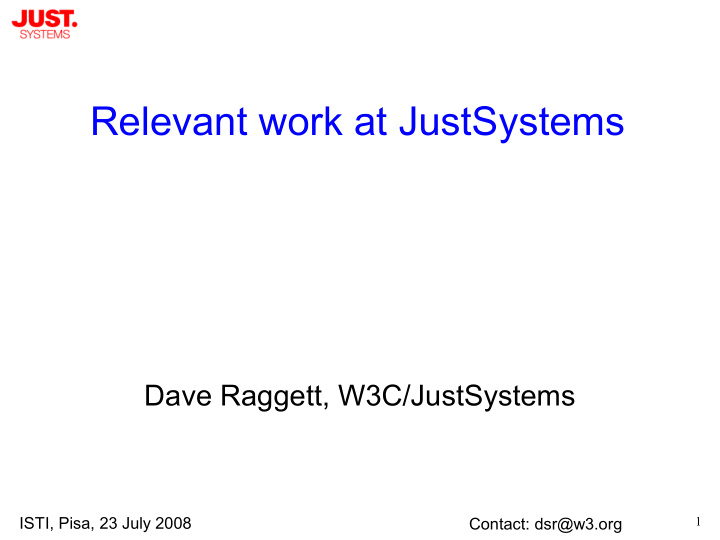



Relevant work at JustSystems Dave Raggett, W3C/JustSystems ISTI, Pisa, 23 July 2008 1 Contact: dsr@w3.org
JustSystems ● Japanese software developer – Headquarters in Tokushima – Founded in 1979 ● In Japan – ATOK Japanese input method – Ichitaro, word processor, drawing tools, etc. – Full member of Unicode Consortium ● XML software – XMetaL XML-based authoring tool – XFY XML data fusion and app development 2
XFY ● The document is the application ● XFY client – Written in Java – View and edit compound documents ● XHTML, SVG, MathML, Chemical ML ● UI markup (a kind of concrete UI) ● Vocabulary components for charts, pie diagrams – Extends XSLT for dynamic bindings ● Source markup kept in sync with UI ● XFY server – XML repository and interfaces to databases, etc. 3
What is a Vocabulary Component? xfy Client Vocabulary Component XML data <XHTML> XHTML Component <sgv> Input Output </svg> SVG Component VC <math> MathML Component Reflect Edit </math> </XHTML> Other
What is VC (Vocabulary Connection)? XML Web browser document Display Display XSLT Hello World! xfy Enterprise Client XML document Display Display VC mechanism (XVCD) Edit Edit Update Update Multi-view
Vocabulary Component Vocabulary Component A vocabulary component defines how to display and edit XML documents How to create vocabulary components: • View Designer • XVCD • JAVA
XVCD ● Extended version of XSLT that allows you to define event handlers – Update source and target DOM trees in response to use input and application events ● xvcd:action element and event attribute – Commands to modify a DOM tree ● xvcd:delete, xvcd:move, xvcd:combine, xvcd:split ● xvcd:insert-at-caret, xvcd:delete-at-caret ● xvcd:set-user-data, xvcd:set-property ● xvcd:start-drag, xvcd-copy-selection ● Can update source and destination DOM trees 7
XFY User Interface Markup ● Markup for menus, toolbars, buttons, pop-ups, keyboard accelerators ● Can be generated via application of XVCD transform to source data ● XVCD then defines the UI behaviour in response to standard UI events ● Plenty of platform commands to choose from – Navigation and bookmarks, undo/redo, ... ● Specialized markup for charts, pie diagrams, ... – Requires tranformation of data into expected format 8
Data Constraints and Calculations ● Use XVCD to specify constraints on data entered by the user – Numbers, dates, times, durations, ranges, etc. – Restrictions on lists (max/min items settable) ● XVCD also allows you to define calculations e.g. where one element's content is the sum of several others 9
XVCD and XForms ● XFY uses a transformational approach that maps source markup to destination markup ● XForms uses XPath for binding data constraints and calculations, but is not based upon XSLT ● XForms defines abstract UI markup and relies on XBL, CSS or other means to map this into a concrete UI ● XForms is in widespread use as a mature W3C specification ● What is the relationship between XForms and conventional model-based UI? 10
XForms A brief introduction 11
XForms Basics ● Separates data from UI ● Data held and submitted as XML ● Optional use of XML Schema for data ● Additional constraints through bind element – XPath expressions on instance data – Required, relevant, read-only, calculated ● Rich set of events and actions – Act on instance data ● Abstract UI elements 12
XForms UI ● Set of abstract UI controls – input, secret, textarea, output, upload – range, trigger, submit, select, select1 – switch, case, toggle, repeat ● Additional information – label, help, hint, alert ● Model-View-Controller design pattern ● Originally designed as replacement for HTML Forms ● But now seen as of wider utility than forms 13
XForms and Model-based UI ● XForms brings lots of real-world requirements ● Is the XForms abstract UI – A complete solution? – Something to extend? – To be ignored as too forms centric? ● How to relate concrete and abstract UI? – Class and superclass? ● How does XForms relate to task models? 14
Recommend
More recommend